In antiquity almost every settlement on the coast was equipped with a harbour. Depending on the hinterland it was a large or a small one. Rome itself, 30 kms from the coast, had to cope with the supply via the river Tiber. From ca. 300 BC there was a military fortress at the mouth of the Tiber, called Ostia 1. It was used for defending the coast against pirates and for the protection of the local salt fields. The population of Rome was originally fed by local products, but over the years that population increased enormously, up to one million inhabitants at the beginning of imperial times. All these people had to be fed. Very soon the local production was no longer sufficient and supplies had to be found in other regions, mainly overseas. The most important commodity was grain, especially from Egypt, but also from Sicily and Sardinia.
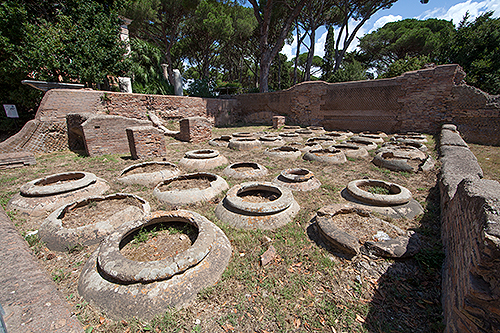
contained 40 amphorae (1040 litres)
Besides grain there was a vivid trade in wine, oil etc., which were shipped towards Rome in large amphorae. The ships did not carry food supplies only, but also iron bars, lead, tin, marble, granite and wild animals for the amphitheatre. The constant transport of those products necessitated specialized ships and the harbours too had to be reorganized for those transports. Large vessels could not sail on rivers upstream, and had to be unloaded in the harbour or put their cargo directly in smaller river ships. Some cargo remained in the harbour for a while and had to be stored. It is logical that after a while a complete infrastructure arose with quays, trade offices, markets and all kinds of ancillary industries for the ships and their overseas trade (cf. Rotterdam, Antwerp, Hamburg). Many Shipmasters who came regularly to a Roman harbour probably found it more convenient to do business there than at Rome and Roman merchants came to meet them in the Port. This also happened to Ostia and later to Portus where complete trade centres appeared.
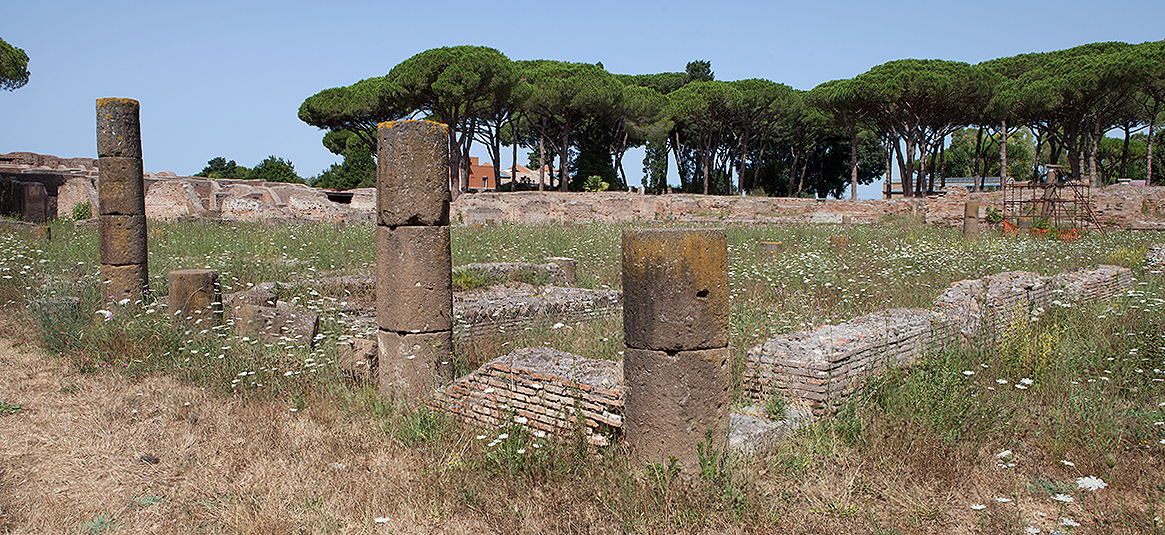
The Piazzale delle Corporazioni
One of the places where we can still find good evidence of such a trade centre is Ostia. Here, behind the theatre we see a gallery formed by of a colonnade and 61 small, probably roofed rooms (stationes). This gallery was indissolubly connected to the theatre and used as a promenade for the visitors of the theatre before or after a show, during an interval or in the case of bad weather.
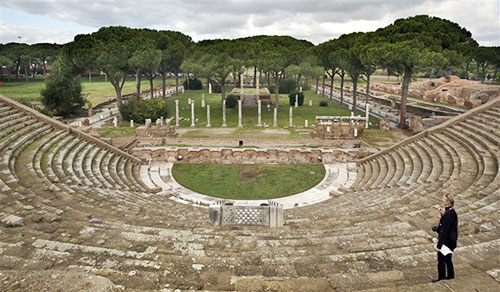
in the background2
The stationes could be bought by anybody, had originally no commercial intention and were related to the theatre itself (sponsoring of plays, sponsoring the maintenance of the building etc.)
After the theatre was rebuilt at the end of the second century and the level was raised many of the stationes were bought by traders from oversea and local traders who could represent themselves and their trade. The mosaic floors on which theatre visitors since that time walked showed often which product and/or country was represented. Many of the floors of the stations from this period have been survived and give us a glimpse of the probable nature of these trade offices.
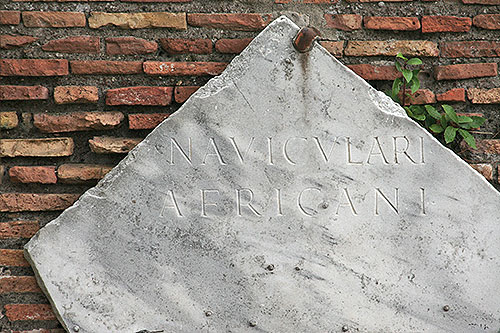
It's all about trust
In the eastern gallery a slab of marble with an inscription has been found. The slab is too heavy as wall decoration of a statio and was perhaps a part of the marble decoration above the eastern entrance door3. On the slab we read:
NAVICVLARI AFRICANI
The shipmasters from Africa
The text suggests that a lot of traders from Africa were represented here.
Nowadays if you have the intention to do business with someone, you can gather all kind of information about your new client (Chamber of Commerce, internet etc.). In antiquity that was not so easy. You often needed a recommendation from already well known and trusted people. Most of the time they were traders from the same origin already living at, in this case, Ostia or Portus. They were united in corporations. For instance a trader from Carthage who liked to do business in Ostia first had to contact the Carthaginian corporation. Via their mediation they were allowed to do business whereby the corporation guaranteed. Also this could be a reason why local living foreigners held office on the Piazzale delle Corporazioni.
Unfortunately only less than halve of the mosaic floors survived. Via the pull-down list you can see each statio separately. Underneath you find a list of which statio is still giving a clue of product or origin.
Stationes from which trade or origine are well known
Makers of and traders in hemp and rope-makers probably from Ostia - statio 1
The guild of the furriers and/or leather from Ostia and Portus - statio 2
Schipmasters who trade in wood - statio 3
Shipmasters trading in grain - statio 4, 5, 7, 33, 38, 53, 55, 56
Shipmasters in grain from Misua (Tunesia) - statio 10
Shipmasters from Musluvium (North Africa) - statio 11
Shipmasters from Julia Hippo Diarrhytus (Tunesia) - statio 12
Traders in wild animals/or ivory from Sabrata (Libya) -statio 14
Shipmasters trading in grain from Gummi (North Africa) - statio 17
Shipmasters from Carthage - statio 18
Shipmasters trading in grain from Turris Libisonis (Sardinia) - statio 19
Shipmasters and traders from Caralies (Sardinia) - statio 21
Shipmasters and traders in oil from Syllectum (Tunesia) - statio 23
Traders from Arelate (Arles) (probably all kind of trade) - statio 27
Traders in wild animals (see 27) - statio 28
Shipmasters from Narbo Marius (Gallia, present France) - statio 32
Shipmasters and traders in grain from Curubis (Tunesia) - statio 34
Shipmasters from Alexandria (Egypt) - statio 40
Tiber shipmasters - statio 43
Traders in wine and dates from Mauretania Caesariensis (Algeria) - statio 48
Makers of and trader in hemp - statio 58
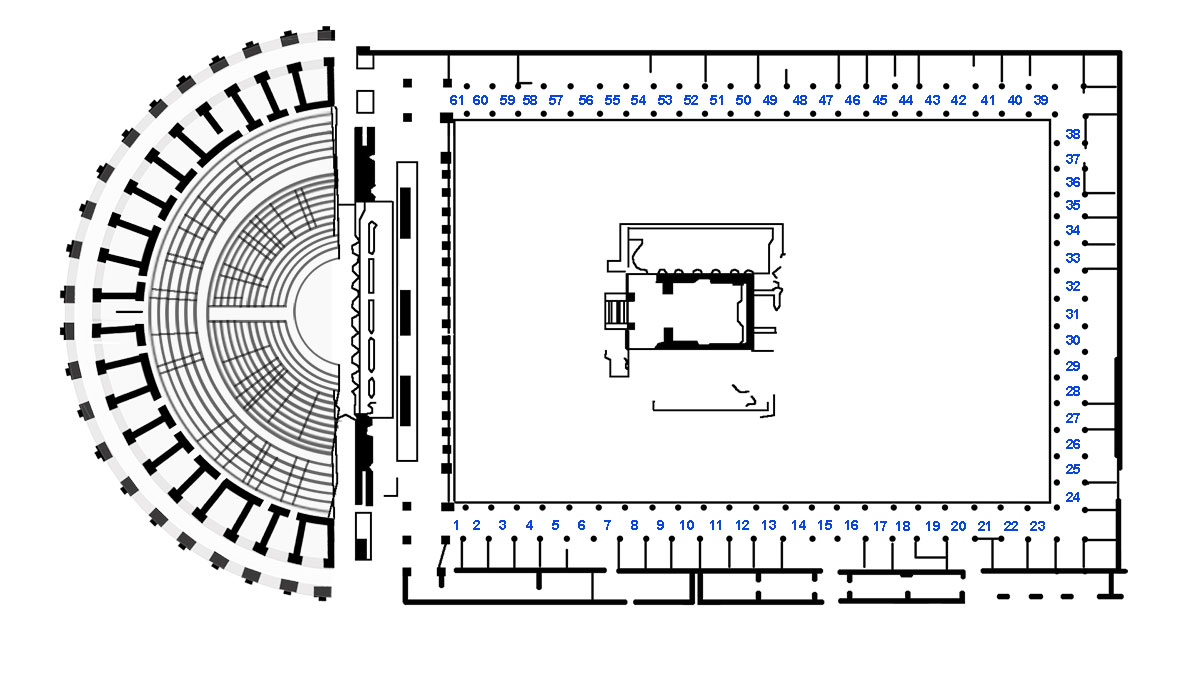
Sources:
L. Bouke van der Meer; 'Ostia Speaks'; Peeters-Leuven 2012
Russell Meiggs: 'Roman Ostia'; At the Clarendon Press-Oxford 1973
J. Th. Bakker: www.ostia-antica.org
Taco T. Terpstra; 'The « Piazzale delle Corporazioni » reconsidered'; Mélanges de l'École française de Rome 126-1/2014
- Notes:
- 1:See article 'A harbour for Rome'
- 2:Photo 3 - Laura Maish-Bill Storage
- 3: Bloch, 44
- 4: Photo 4 - Klaus Heese. zie http://www.ia-ostiaantica.org/news/archivio-heese/






 We are committed to providing versions of our articles and interviews in several languages, but our first language is English.
We are committed to providing versions of our articles and interviews in several languages, but our first language is English.